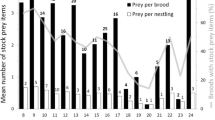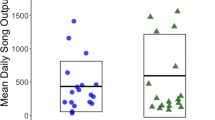Abstract
In animal societies, individuals should optimize the way they behave in relation to the behavior displayed by their conspecifics. This social competence, i.e., the ability to adjust behavior to the social context, can vary between individuals, but also improve with age and experience. This aspect, although important, has rarely been studied. We tested whether the ability to adjust behavior to siblings develops with age in barn owl nestlings (Tyto alba). In this species, young siblings show intense social interactions referred to as “sibling negotiation.” Indeed, because parents bring a single indivisible food item at each visit to the nest, all the effort invested in sibling competition is only paid back in the nestling that is able to monopolize the food item. Therefore, before the arrival of parents, siblings vocally inform each other about their relative hunger level so that they can optimally invest in sibling competition, with the most vocal, and hence hungry, nestling momentarily deterring its siblings from competing. This process implies that siblings have the ability to adjust their behavior in relation to the behavior of their siblings, a process that could change with age. In a series of experiments, we examined how nestlings of different ages respond to the vocal behavior of siblings. We show here that older nestlings adjusted their vocal behavior more finely than younger nestlings in relation to the behavior of their siblings. Elders also more readily refrained from eating in front of a hungry sibling. These patterns could arise because owlets’ social competence develops with age or because they adopt different competitive and cooperative strategies according to their age.
Significance statement
In sibling barn owls, competition for food brought by parents is settled by vocalization. Highly vocal owlets induce their siblings to call less and to let them eat in priority once parents are back with a prey item, a process referred to as “sibling negotiation.” Nestling barn owls adjust their investment in sibling competition according to two parameters: their hunger level and the vocal behavior of their siblings. We analyzed the relative importance of these two parameters in differently aged owlets. Younger owlets adjusted the intensity of vocalizing primarily in relation to their own hunger level, which was efficient in modifying older nestlings’ behavior, as older nestlings readily withdrew from vocal contest and refrained from eating in front of highly vocal siblings. Hence, social adjustment changed with age in owlets, older ones being more sensitive to the signals of need of their siblings.






Similar content being viewed by others
References
Anderson DJ, Ricklefs RE (1995) Evidence of kin-selected tolerance by nestlings in a siblicidal bird. Behav Ecol Sociobiol 37:163–168
Arnott G, Elwood RW (2008) Information gathering and decision making about resource value in animal contests. Anim Behav 76:529–542
Bell MBV (2007) Cooperative begging in banded mongoose pups. Curr Biol 17:717–721
Bowers EK, Sakaluk SK, Thompson CF (2013) Sibling cooperation influences the age of nest leaving in an altricial bird. Am Nat 181:775–786
Bulmer E, Celis P, Gil D (2008) Parent-absent begging: evidence for sibling honesty and cooperation in the spotless starling (Sturnus unicolor). Behav Ecol 19:279–284
Cotton PA, Wright J, Kacelnik A (1999) Chick begging strategies in relation to brood hierarchies and hatching asynchrony. Am Nat 153:412–420
Dall SRX, Giraldeau LA, Olsson O, McNamara JM, Stephens DW (2005) Information and its use by animals in evolutionary ecology. Trends Ecol Evol 20:187–193
D'Andrea I, Alleva E, Branchi I (2007) Communal nesting, an early social enrichment, affects social competences but not learning and memory abilities at adulthood. Behav Brain Res 183:60–66
Dreiss AN, Henry I, Ruppli CA, Almasi B, Roulin A (2010a) Darker eumelanic barn owls better withstand food depletion through resistance to food deprivation and lower appetite. Oecologia 164:65–71
Dreiss AN, Lahlah N, Roulin A (2010b) How siblings adjust sib-sib communication and begging signals to each other. Anim Behav 80:1049–1055
Dreiss AN, Calcagno M, van den Brink V, Laurent A, Almasi B, Jenni L, Roulin A (2013a) The vigilance components of begging and sibling competition. J Avian Biol 44:359–368
Dreiss AN, Ruppli CA, Faller C, Roulin A (2013b) Big brother is watching you: eavesdropping to resolve family conflicts. Behav Ecol 24:717–722
Dreiss AN, Ruppli CA, Roulin A (2014) Individual vocal signatures in barn owl nestlings: does individual recognition have an adaptive role in sibling vocal competition? J Evol Biol 27:63–75
Dreiss AN, Ruppli CA, Antille S, Roulin A (2015a) Information retention during competitive interactions: siblings need to constantly repeat vocal displays. Evol Biol 42:63–74
Dreiss AN, Ruppli CA, Faller C, Roulin A (2015b) Social rules govern vocal competition in the barn owl. Anim Behav 102:95–107
Dreiss AN, Gaime F, Delarbre A, Moroni L, Lenarth M, Roulin A (2016) Vocal communication regulates sibling competition over food stock. Behav Ecol Sociobiol 70:927–937
Drummond H (2006) Dominance in vertebrate broods and litters. Q Rev Biol 81:3–32
Ducret V, Gaigher A, Simon C, Goudet J, Roulin A (2016) Sex-specific allelic transmission bias suggests sexual conflict at MC1R. Mol Ecol 25:4551–4563
Fichtel C (2008) Ontogeny of conspecific and heterospecific alarm call recognition in wild Verreaux’s sifakas (Propithecus verreauxi verreauxi). Am J Primatol 70:127–135
Fischer S, Bessert-Nettelbeck M, Kotrschal A, Taborsky B (2015) Rearing-group size determines social competence and brain structure in a cooperatively breeding cichlid. Am Nat 186:123–140
Giraldeau LA, Valone TJ, Templeton JJ (2002) Potential disadvantages of using socially acquired information. Philos Trans Roy Soc B 357:1559–1566
Godfray HCJ (1995) Signaling of need between parents and young: parent-offspring conflict and sibling rivalry. Am Nat 146:1–24
Gomez JC (2005) Species comparative studies and cognitive development. Trends Cogn Sci 9:118–125
Hamilton WD (1964) The genetical evolution of social behaviour. J Theor Biol 7:1–16
Henry I, Antoniazza S, Dubey S, Simon C, Waldvogel C, Burri R, Roulin A (2013) Multiple paternity in polyandrous barn owls (Tyto alba). PLoS One 8:e80112
Hoffmann A, Ruttler V, Nieder A (2011) Ontogeny of object permanence and object tracking in the carrion crow, Corvus corone. Anim Behav 82:359–367
Joe H, Zhu R (2005) Generalized Poisson distribution: the property of mixture of Poisson and comparison with negative binomial distribution. Biom J 47:219–229
Johnstone RA (1997) The evolution of animal signals. In: Krebs JR, Davies NB (eds) Behavioural ecology: an evolutionary approach, 4th edn. Blackwell Science, Oxford, pp 155–178
Johnstone RA (2004) Begging and sibling competition: how should offspring respond to their rivals? Am Nat 163:388–406
Johnstone RA, Roulin A (2003) Sibling negotiation. Behav Ecol 14:780–786
Just W, Morris MR (2003) The Napoleon complex: why smaller males pick fights. Evol Ecol Res 17:509–522
van Leeuwen EJC, Mulenga IC, Chidester DL (2014) Early social deprivation negatively affects social skill acquisition in chimpanzees (Pan troglodytes). Anim Cogn 17:407–414
Madden JR, Kunc HP, English S, Manser MB, Clutton-Brock TH (2009) Calling in the gap: competition or cooperation in littermates’ begging behaviour? Proc R Soc Lond B 276:1255–1262
Marques PAM, Leonard ML, Horn AG, Contasti A (2011) How nestling tree swallows (Tachycineta bicolor) integrate their responses to hunger and signalling by nestmates. Ethology 117:163–170
Mathevon N, Charrier I (2004) Parent–offspring conflict and the coordination of siblings in gulls. Proc R Soc Lond B 271:S145–S147
Maynard Smith J (1982) Do animals convey information about their intentions? J Theor Biol 97:1–5
Mesterton-Gibbons M, Heap SM (2014) Variation between self- and mutual assessment in animal contests. Am Nat 183:199–213
Munn CA (1986) Birds that “cry wolf”. Nature 319:143–145
Oliveira RF, McGregor PK, Latruffe C (1998) Know thine enemy: fighting fish gather information from observing conspecific interactions. Proc R Soc Lond B 265:1045–1049
Parker GA (1974) Assessment strategy and evolution of fighting behavior. J Theor Biol 47:223–243
Parker GA, Mock DW, Lamey TC (1989) How selfish should stronger sibs be? Am Nat 133:846–868
Patricelli GL, Uy JAC, Walsh G, Borgia G (2002) Sexual selection: male displays adjusted to female’s response. Nature 415:279–280
Patricelli GL, Krakauer AH, McElreath R (2011) Assets and tactics in a mating market: economic models of negotiation offer insights into animal courtship dynamics on the lek. Curr Zool 57:225–236
Petrazzini MEM, Agrillo C, Piffer L, Bisazza A (2014) Ontogeny of the capacity to compare discrete quantities in fish. Dev Psychobiol 56:529–536
Romano A, Boncoraglio G, Rubolini D, Saino N (2013) Parent-absent signalling of need and its consequences for sibling competition in the barn swallow. Behav Ecol Sociobiol 67:851–859
Roulin A (2002a) Short- and long-term fitness correlates of rearing conditions in barn owls Tyto alba. Ardea 90:259–267
Roulin A (2002b) The sibling negotiation hypothesis. In: Wright J, Leonard ML (eds) The evolution of begging: competition, cooperation and communication. Kluwer Academic Press, Dordrecht, pp 107–127
Roulin A (2004a) Covariation between plumage colour polymorphism and diet in the barn owl Tyto alba. Ibis 146:509–517
Roulin A (2004b) The function of food stores in bird nests: observations and experiments in the barn owl Tyto alba. Ardea 92:69–78
Roulin A, Kölliker M, Richner H (2000) Barn owl (Tyto alba) siblings vocally negotiate resources. Proc R Soc Lond B 267:459–463
Roulin A, Dreiss AN, Fioravanti C, Bize P (2009) Vocal sib-sib interactions: how siblings adjust signalling level to each other. Anim Behav 77:717–725
Roulin A, Da Silva A, Ruppli CA (2012) Dominant nestlings displaying female-like melanin coloration behave altruistically in the barn owl. Anim Behav 84:1229–1236
Roulin A, des Monstiers B, Ifrid E, Da Silva A, Genzonia E, Dreiss AN (2016) Reciprocal preening and food sharing in colour-polymorphic nestling barn owls. J Evol Biol 29:380–394
Royle NJ, Pike TW, Heeb P, Richner H, Kölliker M (2012) Offspring social network structure predicts fitness in families. Proc R Soc Lond B 279:4914–4922
Ruppli CA, Dreiss AN, Roulin A (2013a) Efficiency and significance of multiple vocal signals in sibling competition. Evol Biol 40:579–588
Ruppli CA, Dreiss AN, Roulin A (2013b) Nestling barn owls assess short-term variation in the amount of vocally competing siblings. Anim Cogn 16:993–1000
Saino N, Incagli M, Martinelli R, Ambrosini R, Møller AP (2001) Immunity, growth and begging behaviour of nestling barn swallows Hirundo rustica in relation to hatching order. J Avian Biol 32:263–270
Scheiber IBR, Weiss BM, Kingma SA, Komdeur J (2017) The importance of the altricial-precocial spectrum for social complexity in mammals and birds—a review. Front Zool 14:3
Svensson PA, Lehtonen TK, Wong BBM (2012) A high aggression strategy for smaller males. PLoS One 7:e43121
Taborsky B, Oliveira RF (2012) Social competence: an evolutionary approach. Trends Ecol Evol 27:679–688
White DJ, Gersick AS, Freed-Brown G, Snyder-Mackler N (2010) The ontogeny of social skills: experimental increases in social complexity enhance reproductive success in adult cowbirds. Anim Behav 79:385–390
Acknowledgments
We thank three anonymous reviewers for their comments.
Author information
Authors and Affiliations
Corresponding author
Ethics declarations
Animal welfare and ethical approval
Experiments were done under the legal authorization of the Veterinary Office (Vaud Canton, Switzerland). Nestlings recorded in the laboratory were not physiologically stressed, as shown by the absence of a rise in baseline corticosterone levels compared to the situation prevailing under natural, undisturbed conditions (Dreiss et al. 2010a). Keeping owlets at the described enclosures a few days did not negatively affect their body condition, since mean body mass and survival at fledgling did not differ between experimental nestlings and nestlings remaining in their nest during all rearing period (Dreiss et al. 2013b).
Conflict of interest
The authors declare that they have no conflict of interest.
Data availability
The datasets analyzed in the current study are available in the Figshare repository: http://figshare.com/s/8f32301d4cdd2636e419.
Additional information
Communicated by M. Leonard
Rights and permissions
About this article
Cite this article
Dreiss, A.N., Ruppli, C.A., Delarbre, A. et al. Responsiveness to siblings’ need increases with age in vocally negotiating barn owl nestlings. Behav Ecol Sociobiol 71, 109 (2017). https://doi.org/10.1007/s00265-017-2342-0
Received:
Revised:
Accepted:
Published:
DOI: https://doi.org/10.1007/s00265-017-2342-0




